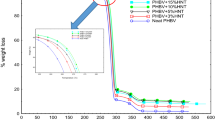Abstract
The aim of this work is to evaluate the effect of poly-ε-caprolactone addition and concentration on the gas permeability, tensile properties and biodegradation of PBAT/PCL blends prepared by extrusion in a bench scale single-screw extruder. The blends were characterized by scanning electron microscopy (SEM), tensile properties, permeability to oxygen (O2) and carbon dioxide (CO2) gas and biodegradation in soil. Our data indicate that PCL addition to poly(butylene adipate-co-terephthalate) (PBAT) increases its permeability to both O2 and CO2. The tensile properties of the blends are sensitive to PCL concentration and, particularly, their modulus is higher than that of PBAT. SEM images did not show changes in PBAT morphology upon PCL incorporation and content. Biodegradation (bio-disintegration) in soil was shown to increase with both the presence and content of PCL in the blends. Incorporation of up to 25% of PCL to PBAT can be suitable to develop materials with high potential of biodegradation with preserved tensile properties. The higher permeability upon blending with PCL can also be useful in applications such as cooking food coated with polymeric films.








Similar content being viewed by others
References
Palsikowski PA, Kuchnier CN, Pinheiro IF, Morales AR (2017) Biodegradation in soil of PLA/PBAT blends compatibilized with chain extender. J Polym Environ 26:1–12
Weng Y-X, Jin Y-J, Meng Q-Y, Wang L, Zhang M, Wang Y-Z (2013) Biodegradation behavior of poly(butylene adipate-coterephthalate) (PBAT), poly(lactic acid) (PLA), and their blend under soil conditions. Polym Test 32:918–926
Razepna M, Przybytniak R, Sadło J (2018) Radiation degradation and stability of PBAT: copolymer of aromatic and aliphatic esters. J Appl Polym Sci 46682:1–8
Yamamoto M, Witt U, Skupin G, Beimborn D, Müller RJ (2002) Biodegradable aliphatic-aromatic polyesters:“Ecoflex®.” In: Steinbüchel A, Doi Y (eds) Biopolymers: polyesters III – Applications and commercial products, vol 4. Wiley, New York
Chaves RP, Fechine GJM (2016) Thermo stabilisation of poly (butylene adipate-co-terephthalate). Polímeros 26:102–105
Al-Ltry R, Lamnawara K, Maazouz A (2012) Improvement of thermal stability, rheological and mechanical properties of PLA, PBAT and their blends by reactive extrusion with functionalized epoxy. Polym Degrad Stab 97:1898–1914
Fukushima K, Rasyida A, Yang MC (2013) Biocompatibility of organically modified nanocomposites based on PBAT. J Polym Res 20:302
Chen JH, Chen CC, Yang MC (2011) Characterization of nanocomposites of poly (butylene adipate co-terephthalate) blending with organoclay. J Polym Res 18:2151–2159
Someya Y, Kondo N, Shibata M (2007) Biodegradation of poly(butylene adipate-co-butylene terephthalate)/layered-silicate nanocomposites. J App Polymer Sci 106:730–736
Someya Y, Sugahara Y, Shibata M (2005) Nanocomposites based on poly(butylene adipate-co-terephthalate) and montmorillonite. J App Polymer Sci 95:386–392
Wang L-F, Rhim J-W, Hong S-I (2016) Preparation of poly(lactide)/poly(butylene adipate-co-terephthalate) blend films using a solvent casting method and their food packaging application. Food Sci Technol 68:454–461
França DC, Morais DDS, Bezerra EB, Araújo EM, Wellen RMR (2018) Photodegradation mechanisms on poly(ε-caprolactone) (PCL). Mater Res 21(5):e20170837
Ludueña LN, Vázquez A, Alvarez VA (2012) Effect of lignocellulosic filler type and content on the behavior of polycaprolactone based eco-composites for packaging applications. Carbohyd Polym 87:411–421
Almeida TG, Silva Neto JE, Costa ARM, Silva AS, Carvalho LH, Canedo EL (2016) Degradation during processing in poly(butylene adipate-co-terephthalate)/vegetable fiber compounds estimated by torque rheometry. Polym Test 55:204–211
Falcão GAM, Almeida TG, Bardi MAG, Carvalho LH, Canedo EL (2019) PBAT/organoclay composite films — part 2: effect of UV aging on permeability, mechanical properties and biodegradation. Polym Bull 76:291–301
Marinho VAD, Pereira CAB, Vitorino MBC, Silva AS, Carvalho LH, Canedo EL (2017) Degradation and recovery in poly(butylene adipate-co-terephthalate)/thermoplastic starch blends. Polym Test 58:166–172
Santos TT, Almeida TG, Morais DDS, Magalhães FD, Guedes RM, Canedo EL, Carvalho LH (2020) Effect of filler type on properties of PBAT/organoclay nanocomposites. Polym Bull 77:901–917
Sousa FM, Costa ARM, Reul LTA, Cavalcanti FB, Carvalho LH, Almeida TG, Canedo EL (2018) Rheological and thermal characterization of PCL/PBAT blends. Polym Bull 76:1573–1593
Jost V (2018) Packaging related properties of commercially available biopolymers – An overview of the status quo. Express Polym Lett 12:429–435
Bezerra EB, França DC, Morais DDS, Rosa MF, Morais JPS, Araújo EM, Wellen RMR (2017) Processing and properties of PCL/cotton linter compounds. Mater Res 20(2):317–325
Falcão GAM, Vitorino MBC, Almeida TG, Bardi MAG, Carvalho LH, Canedo EL (2017) PBAT/organoclay composite films: preparation and properties. Polym Bull 74:4423–4436
Boonprasertpoh A, Pentrakoon D, Junkasem J (2017) Investigating rheological, morphological and mechanical properties of PBS/PBAT blends. J Metal, Material, Mineral 27:1–11
Fukushima K, Rasyida A, Yang MC (2013) Characterization, degradation and biocompatibility of PBAT based nanocomposites. Appl Clay Sci 80–81:291–298
Acknowledgements
The authors thank to Federal University of Campina Grande (UFCG) for support and are grateful for the fellowships provided by Coordenação de Aperfeiçoamento de Pessoal de Nível Superior (CAPES) in favor of Morais (PNPD), Sousa (PhD), Marinho (PhD) and Cavalcanti (MSc) and Conselho Nacional de Desenvolvimento Científico e Tecnológico (CNPq) in favor of Carvalho (PQ) and Almeida (PDJ#160909/2019-8).
Author information
Authors and Affiliations
Corresponding author
Additional information
Publisher's Note
Springer Nature remains neutral with regard to jurisdictional claims in published maps and institutional affiliations.
Rights and permissions
About this article
Cite this article
Sousa, F.M., Cavalcanti, F.B., Marinho, V.A.D. et al. Effect of composition on permeability, mechanical properties and biodegradation of PBAT/PCL blends films. Polym. Bull. 79, 5327–5338 (2022). https://doi.org/10.1007/s00289-021-03745-3
Received:
Revised:
Accepted:
Published:
Issue Date:
DOI: https://doi.org/10.1007/s00289-021-03745-3




